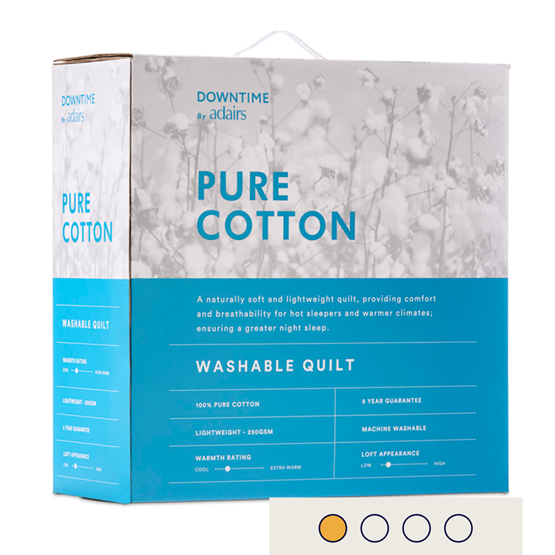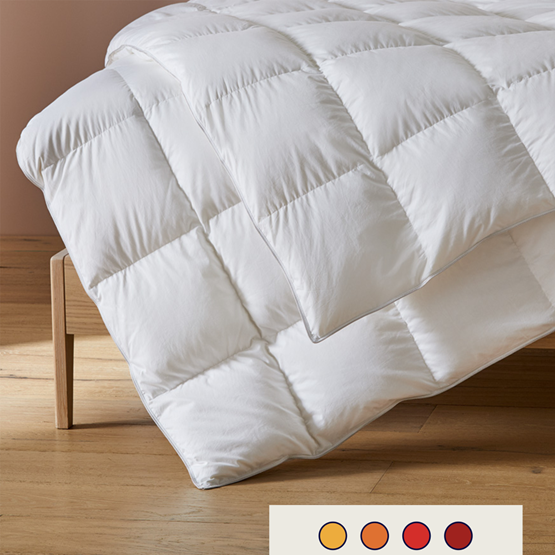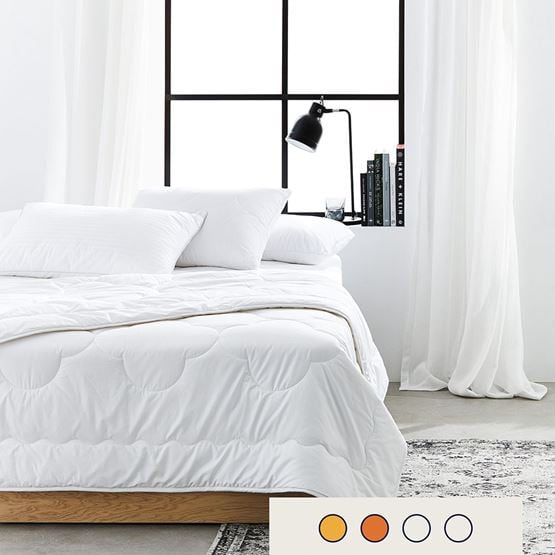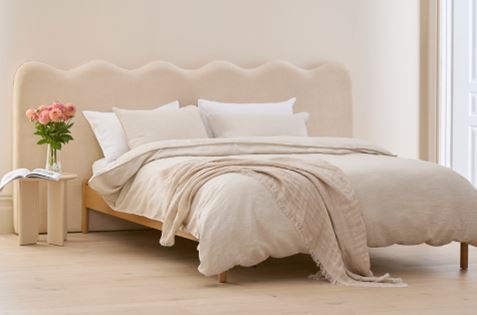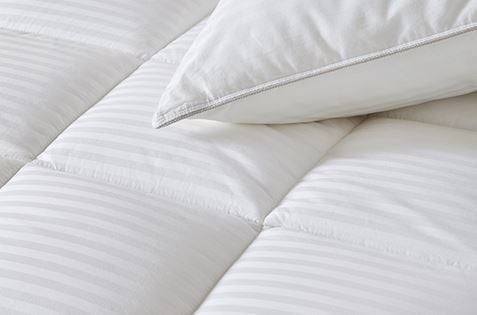- New In
- Bedroom
- Bathroom
- Furniture
- Homewares
- Kids
- Gifting
- Sale
- Linen Lovers
- Adairs Insider
Guides
Your Perfect Quilt
MAR 01|4 min read
Here's everything you need to know to build your best bed ever.

Introducing Word on our Quilts
Our expert store team is our go-to for all things home advice. That’s why we’ve headed to some of our most experienced team members to find out what you’re asking! We chatted Quilts with Josua, a Store Member from Chadstone, VIC, who’s worked at Adairs for almost 8 years.
There are a few things to consider when it comes to choosing your perfect quilt.
We’ve done the work for you and served up a range based on the way you like to sleep. Explore our range of quilts by their warmth rating and composition to invest in a better night’s sleep, whether you’re a hot sleeper, a cold sleeper or prefer a quilt that is light or lofty.
Firstly, consider what climate you want the quilt for; is your quilt for summer or winter? Or do you live in the kind of climate that never gets particularly cold? With temperature ratings from cool to extra warm, our range of quilts suits all seasons and climates.
The next thing to think about is allergies; is your new quilt for someone who has sensitivities? Along with what temperature rating you need, allergens will also factor into your choice of filling.
Additionally, you’ll want to consider who your quilt is for. Kids will benefit from durable quilts that won’t soil easily, while a mid-temperature quilt is perfect for the guest bedroom, so you can use it for all seasons.
If picking the perfect quilt still feels a bit complicated – or you feel overwhelmed by choice – keep reading as we break down everything you need to know about bedding.
What are Loft and GSM?
The first thing you’ll notice when you start researching quilt types is that the words ‘loft’ and ‘GSM’ appear in almost every description. Put simply, the loft is how thick a quilt is, while GSM refers to how much filling the quilt has. Loft is primarily used for aesthetic purposes; the higher the loft, the bigger and fluffier the quilt will look. Loft does not have a large impact on warmth but will instead affect how it feels to be bundled up under your quilt. A high loft quilt is usually about as thick as three blankets.
GSM stands for “grams per square metre” and is one of the ways warmth is measured. Your typical winter quilt will be at least 500 GSM, while an autumn quilt will be between 300-350 GSM, and a light summer quilt will be 250 GSM or less. If you prefer a heavy quilt opt for a higher GSM.
What size quilt should you buy?
Buying the right size quilt seems straightforward – surely a queen-size quilt is made for a queen-size bed? However, we always recommend purchasing a quilt one size larger than your mattress.
A larger quilt will luxuriously drape over the sides of your bed, creating a sumptuous look that helps cover your mattress. A larger quilt will also keep you warmer, as it will stop draughts from getting in, cover more of you when you’re in bed, and is perfect if you have a partner that likes to steal the covers. Plus, buying one size up from your mattress means you don’t immediately need to buy a new quilt, should you upsize your bed.

Insider Tip:
Bed sizes are not standard, internationally. If you have an Australian mattress, we recommend buying your bedding and bedlinen from Aussie stores like Adairs, to make sure the dimensions match your bed.
Allergen-free options
Animal-derived fibres like feather and wool have been known to cause reactions in those with sensitivities. You might be having a reaction to your bedding if you regularly wake up to a stuffy nose, sneezing, a cough, or even itchy eyes. You may also experience poor sleep quality if your quilt filling isn’t letting you breathe easily. If this sounds like you or someone in your family, try out an allergen-free filling like cotton, bamboo, silk, or synthetic material. One thing to keep in mind, however, is that dust mites cause reactions just as often as animal fibres. A good, dust-mite-resistant mattress topper and frequent laundry is a must if swapping your filling hasn’t provided any relief.
Understanding filling
We know that quilts keep you warm – but how? When you slide into bed, the warmth from your body begins to warm the filling; as the fibres expand, they trap 1,000s of tiny pockets of air. These pockets of insulation warm up from your body heat, creating a soft layer of comfort. As such, quilts are a far more effective insulator than blankets, which simply provide a barrier between your body and the cold air.
The right filling is all about how you personally like to sleep; do you want something breathable or extra warm? A heavy quilt or a light quilt? Is moisture wicking important for you? We explore the benefits of each filling below.
Choosing the best fill material for your quilt:

Bamboo Quilt
Warmth Rating: Warm
Composition: Bamboo fibre
Weight: Light - Medium
Key features:
- Breathable and temperature regulating
- Naturally antibacterial
- Absorbent – perfect for hot sleepers
Allergy sufferers rejoice, bamboo quilt is here to help you sleep well. Naturally hypoallergenic and resistant to dust mites, bamboo won’t cause a reaction in people with sensitivities – meaning you’ll wake up feeling fresh, not stuffy. Naturally anti-bacterial, bamboo quilt also won’t allow bacteria, fungus, mould, or other nasties to grow, for a better night’s sleep. Breathable and moisture-wicking, bamboo quilt will feel good in all seasons. Plus, bamboo is an eco-friendly choice.

Cotton
Warmth Rating: Cool
Composition: Australian cotton
Weight: Light
Key features:
- Made from 100% Australian cotton
- Natural breathable fibre
- Low loft that is comfortable & breathable

Feather & Down
Warmth Rating: Warm – Extra Warm
Composition: Range of feather fill and goose down blend options
Weight: Light - Medium
Key features:
- Our high luxury range
- RDS certified
- Provides warmth with a light lofty feel
- Suitable for cold sleepers
The classic quilt filling, feather and down quilt provides plenty of warmth. Down quilt provides the most insulation, while the feather provides weight. The most opulent quilts have a higher percentage of down to feather and are some of the warmest on the market. A quilt with a high percentage of down to feather will be warm while still being lightweight. Feather and down quilts are durable and lofty, making them a great all-rounder.

Memory Fibre (Polyester)
Warmth Rating: Warm – Extra Warm
Composition: Range of innovative polyester fibres
Weight: Medium - Heavy
Key features:
- Great alternative to feather & down
- Medium to High loft for plush look and feel
- Treated with Ultra FreshTM for protection against bacteria
- Ideal for cold sleepers
If you’ve got lots of beds to cover, a synthetic quilt is a great choice. Modern polyester quilt is excellent at mimicking the high loft of down at a much more affordable price point. With an easy-care construction, you’re able to wash a synthetic-filled quilt more often than other kinds. This regular washing (bye, dust mites!) and allergen-free material makes synthetic an excellent choice for allergy sufferers.

Silk
Warmth Rating: Cool - Warm
Composition: 100% Mulberry Silk
Weight: Light – Medium
Key features:
- A luxurious super soft duvet
- Naturally hypoallergenic
- Silk layering allows body temperature to regulate throughout the night
Silk and summertime are the perfect pairing. A natural fibre, silk is incredibly breathable and thermoregulating - making it ideal for hot nights. Silk quilts tend to be lightweight yet are some of the most durable on the market. Even better than that, silk doesn’t draw moisture out of your skin and hair, which will help keep sensitive skin types happy. Those with dry skin, eczema, or sunburn will love how silk feels, night after night.

Wool
Warmth Rating: Cool – Extra Warm
Composition: Range of 100% Australian Wool, and Wool & Cotton blends
Weight: Light - Heavy
Key features:
- Made from Australian wool
- Range of warmth ratings, suitable for all sleepers
- Low loft that is comfortable & breathable
- Treated with Ultra FreshTM for protection against bacteria
Another classic, wool quilt is a favourite amongst families. Incredibly durable with soil-resistant properties, wool is a great choice for kids. Just like it does when it’s on the sheep, wool provides temperature regulation and is super breathable - meaning it’s ideal for hot sleepers or year-round use. The moisture wicking properties make it the right choice if you’re trying to avoid those clammy, sweaty nights. Plus, wool is a renewable resource so you can feel good about your filling.
Choosing the right quilt for the season is crucial for achieving optimal comfort and sleep quality. All-season quilts also offer versatility, with some allowing you to adjust layers. Once you’ve found your perfect quilt, make sure to follow the care instructions on the tag to keep it in good condition for years to come. Some quilts are dry clean only, while others are machine washable. Keep drying time in mind – a quilt can only go back on your bed once it’s completely dry.
If you’re packing away a seasonal quilt, we recommend using a zippered storage bag to keep the unused one safe and giving it a fresh spritz of Aroma Wash before it goes in the cupboard.
Sleep well with Adairs.

We're here to help.
From breathable Bamboo to luxe Feather and Down, there’s an Adairs quilt for everybody and every season.
If you’re feeling overwhelmed by the difference between ‘loft’ and ‘GSM’, head in-store and let our expert team provide tailored advice.

